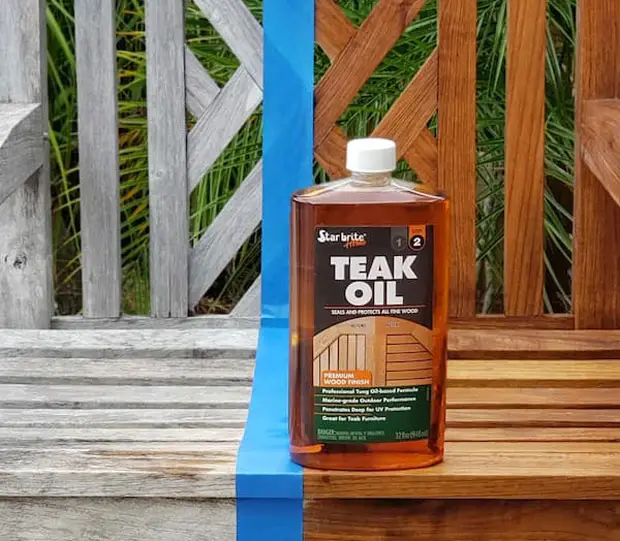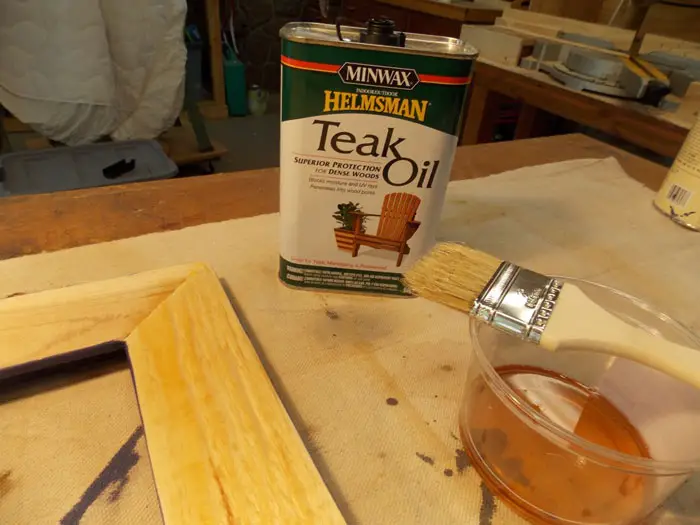Teak Oil Vs Linseed Oil: How They Compared And Which To Use?
Finishing products are ideal for most woodworking projects. They make the wooden surface appealing and protect them against damage. The two common types of finishes used are teak oil and linseed oil.
But how do teak oil vs linseed oil compare? Teak oil creates a stronger cover with the wood and is easy to reapply compared to linseed oil. However, linseed oil maintains its appearance for a long time and is cheaper to buy. These and other differences make them suitable for different projects.
The article discusses these two types of finishes, including what they are, their differences, and suitable projects. Read on to learn more.
Teak Oil and Linseed Oil Overview

Wood finishes better the wood’s appearance, making it more appealing and protected. Teak oil and linseed oil are among the go-to finishes used on many projects.
What is Teak Oil?
Teak oil is a clear finish made by mixing various types of oils, including tung and linseed oils. Tung oil, one of the two oils used in its making, comes from seeds of the tung tree’s (Vernicia fordii) nut. Teak oil also contains additives, synthetic resins, and solvents.
Teak oil gives the wood’s surface an appealing matt finish that protects the wood from moisture and UV rays. This finish is mainly used in boats and outdoor furniture.

What is Linseed Oil?
Linseed oil, also called flaxseed oil, is a slightly yellow wood oil made as a finish. This finishing oil is made from flax seeds, which makes it a non-toxic and eco-friendly option.
The oil is used when raw, boiled, or double-boiled, which increases their drying time. The wood is known for its penetrative ability to seep deep into the wood, increasing protection and bettering the appearance.

Teak Oil vs. Linseed Oil Comparison
Teak oil, and linseed oil have several differences that help dictate their suitable projects. The table below overviews these differences, which are discussed in depth below.
| Factors | Teak Oil | Linseed Oil |
|---|---|---|
| Durability | Creates a strong hard cover over the wood | Retains the appealing appearance longer |
| Removability | Easily removed and reapplied | Complex to remove or reapply |
| Water Resistant | Water-resistant | Water-resistant but can get water rings |
| Drying Time | Faster Drying time(hours) | Slow drying time(24+ hours) |
| Outdoor Use | Suitable for outdoor | Unsuitable for outdoor |
| Indoor Use | Suitable for Indoor | Suitable for indoor |
| Coats | Few coats | More coats |
| Combustibility | Less Combustible | Combustible |
| Price | Expensive | Cheaper |
1. Durability
Both teak and linseed oils have good penetrative capabilities that contribute to their better durability. However, teak oil loses its luster after some time, but the hard cover protects the wood for a long time.

While linseed oil does not create a hard cover over the wood, it retains the luster for a long time. Also, teak oil requires frequent reapplication to maintain its protective properties.
2. Removability
As mentioned earlier, teak oil gets hard after drying, which makes it easy to remove or add another layer when maintaining it. On the other hand, Linseed oil doesn’t harden, and removing it or reapplying another finish on it is more complicated.

3. Water and UV Resistance
Both finishes prosper in keeping water and moisture off the wood they are applied on. However, linseed oil can get water rings after prolonged exposure to water.
Teak oil offers better protection against photodegradation by ultraviolet rays, compared to linseed oil, but is not completely UV resistant. Linseed oil used in areas susceptible to high UV exposure is added to UV-resistant varnish topcoats.
4. Drying Time
Teak oils have better drying times due to the additives and solvents used in making. This finish dries within hours after application, after which the next layer is ready for application.
Linseed oil takes a long to dry, even the boiled version. The longer drying time is because of the higher number of double bonds in fatty acids, including alpha-linolenic acid. This finish also forms a film during drying, which slows drying.

5. Number of Coats
The number of coats used varies with the wood type and the desired level of protection. However, teak often requires fewer coats, usually 2 or 3, for optimal results.
Linseed oil requires between 2 to 5 coats, depending on the desired level of protection.
6. Suitable Use Location (Outdoor or Indoor)
Teak oil suits outdoor use due to its superior UV and water resistance capabilities. It also enhances the natural color and grain of the wood it’s applied on.
Linseed oil suits indoor use as it is more susceptible to UV light and water damage.

7. Combustibility
Linseed oil, especially boiled linseed oil, is highly combustible. The rags from the linseed can spontaneously combust if not disposed of well. However, teak oil is also combustible and should be stored well.
Check the following video of a case with linseed oil.
8. Price
Teak oil is usually pricier than linseed oil, with prices ranging between $15 to $30 for a quart. Linseed oil usually costs less than $20 for a quart, but some may cost more.
Teak Oil vs Linseed Oil: Which Should I Use in My Project?
Teak and linseed oil can suit different projects better due to their various advantages and disadvantages discussed above. The following section covers various projects that will suit each finish better.

When to use teak Oil
The following are the various projects that suit teak oil.
- Dealing With Hard Woods
Use teak oil when dealing with dense wood types, including Douglas fir, teak, and mahogany.
- Outdoor Furniture
Use teak oil when working on outdoor furniture, like benches, stools, and tables, usually made of teak wood.

- Faster Drying Time
Teak oil is also suitable for use in projects that require finishing faster. The faster drying time compared to linseed oil serves as an advantage, making it a suitable option.
- Enhancing Wood Grain
As earlier stated, teak oil enhances the wood colors and grain pattern. Use teak oil as a finish when you’re after a warm and natural appearance.
When To Use Linseed Oil
The following are the various projects that suit linseed oil better.
- Food-Related Wooden Items
Raw linseed oil can be used as a finish for wooden items used for food preparation and eating. Raw linseed oil is food-safe since it’s natural and doesn’t have additional ingredients and chemicals.
Use it for cutting boards, wooden spoons, and bowls. However, boiled linseed oil is unsafe and shouldn’t be used on food items.
- Indoor Wood Projects
Linseed oil suits indoor wood projects like finishing the cabinets and furniture. Its ability to retain the luster for a long time allows these furniture items to remain vibrant for a long time.

- Tight Budget
Also, as mentioned earlier, linseed oil is cheaper than teak oil. When working on a tight budget, linseed oil is a great option.
FAQs
The following section lists the questions and answers frequently asked about teak and linseed oil.
Q1. Can You Apply Teak Oil and Linseed Oil Together?
In most cases, you can use the two types of finishes together, which gives the wood unique results. You can use linseed oil as a base coat and later apply teak oil as the top coat.
Q2. Does Linseed Oil Darken Wood More Than Teak Oil?
Linseed oil tends to darken wood after application compared to teak oil. The teak oil thickens and forms a film when drying, which causes the wood color to darken slightly.
Q3. Which Finish Is Easier To Apply Between Linseed and Teak Oil?
The thinner consistency in teak oil makes it easier and faster to spread when applying. Raw linseed oil is slightly thicker and yet more demanding during application.
Final Thoughts
In conclusion, teak and linseed are great finishes to use in your project. The two finishes have differences that you can use to determine the type to use. For most outdoor wooden item projects, use teak as it is better resistant to UV light and water damage.
On the other hand, linseed oil makes a budget and eco-friendly option for indoor use. However, to use this type, be ready to spend much time between coats as it dries slower.




